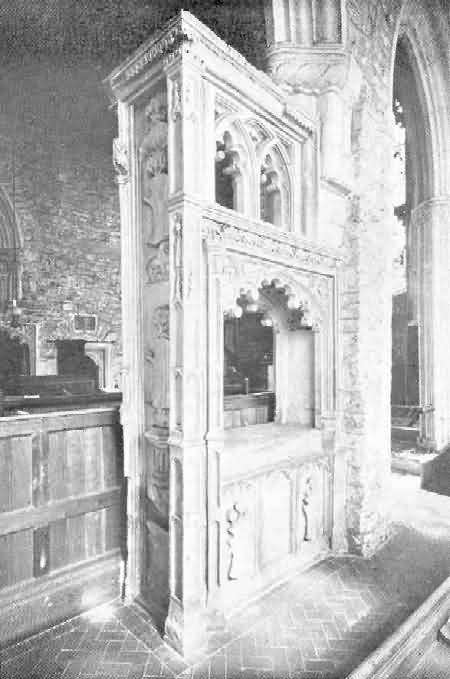
«SOME OLD DEVON CHURCHES» BY JOHN STABB; 157-168
Marldon [157]; Marwood [158]; Membury [159]; Milton Damerel [160]; Molland [161]; Monkleigh [162]; Morchard Bishop [163]; Moretonhampstead [164]; Mortehoe [165]; Musbury [166]; Netherexe [167]; Newton St. Cyres [168].
MARLDON. St. John the Baptist. The church consists of chancel, nave, north and south aisles, separated from the nave by four fluted columns with carved capitals, south porch with groined roof, the bosses having shields of arms, holy water stoup, parvise (the door and staircase remaining), and west tower with five bells. In the south aisle are two piscinas, one to the west of the priest's door, and the other to the east, both having shelves. The floor level of the chancel must have been considerably raised, as the entrance through the priest's door is by a high step up into the chancel.
In the east window of the south aisle are some remains of old glass, bearing the arms of the Cary family. In the chancel are several old tombstones, one, with an inscription in memory of Edward Cary, bears the date 1654, another to [Humphrey] Gilbert [1539-1583], half-brother of Walter Ralegh [1552-1628], dated 1661; and a third has a partly obliterated inscription:— Hic jacet Abrahami Peter De Compto ¾¾ Septimo Die Septembris Ano Dom 1632.
The stone rood screen has been removed from the chancel, and the fragments are stored in the parvise, portions of screen work remain on the north and south sides of the chancel [plate 157]; on the south side this takes the form of a high tomb beneath a canopy; there are shields for arms, but the arms are missing. On the front and side are niches for statues, but these have been removed with the exception of two at the top, apparently figures of ecclesiastics.
Under the canopy, on the north side of the chancel is the recumbent figure of Otho Gilbert [died 1547], sadly mutilated, the arms are broken off, and the feet are damaged. The bare-headed figure, with long hair, is arrayed in armour, and there are spurs on the feet, the sword is gone but the belt round the waist remains.
The registers date: baptisms, 1602; marriages, 1598; burials, 1598.
MARWOOD. St. Michael and All Angels. The Perpendicular church consists of chancel, nave, north and south aisles, south porch, and embattled west tower with six bells cast in 1771.
There are remains of an exceptionally fine rood screen erected in 1520. Early in the last century [19th] the vicar removed the chancel section, and all that is now left is the portion in the north aisle consisting of three bays [plate 158a]. The ancient gallery back remains, but only a small portion of it can be seen, as the chapel is used as an organ chamber, and the screen is hidden by the pipes of the organ. The gallery front on the west side was removed about 60 years since [ca. 1850]. The carving is of the finest description, the fillings of the groining [plate 158b] are very like the work at Atherington. The lower panels [plate 158c] are also richly carved and have the inscription:— Sir J. Brapaul P.son of Marwood. He was rector in 1520, so this gives us the approximate date of the screen. In the majority of cases the panels of the Devonshire screens are ornamented with paintings of saints, Prophets, Apostles, and the Doctors of the Church [St. Gregory the Great, St. Ambrose, St. Augustine, and St. Jerome], but in a few instances they are carved, as is the case here, and it certainly adds to the rich appearance of the screen.
The chancel retains an Early English piscina; the south porch has a sundial made by a parishioner called John Berry in 1762, which shows the approximate time at the principal capitals of Europe and at Jerusalem. There is some old church plate, including a flagon dated 1671, alms dish 1678, paten 1714, and a cup with cover of the time of Elizabeth [1558-1603].
The registers date from 1602.
MEMBURY. St. John the Baptist. The church consists of chancel, with piscina and priest's door, nave, south aisle, separated from nave by four arches, north transept, south porch with holy water stoup, and west tower. The east end of the aisle is enclosed by a screen of two bays, and a doorway retaining its doors [plate 159a]. The cornice is plain and the screen never had any groining. Over the door is painted a coat of arms, that of the Fry and Langton families, and the lower panels are ornamented with linen-fold pattern. This screen forms the entrance to the Yarty Chapel. There is an estate in the parish called Yarty House, now a farmhouse belonging to the Yarty family, whose heiress in 1406 brought it to John Fry. Their descendants were for many generations important people in the neighbourhood, intermarrying into the Yonge and other families, and in the chapel we find their monuments.
Just inside the screen, on the right hand side, is the monument of the Fry family, with figures of a man and a woman kneeling facing each other, with a prie-dieu, with a book and skull carved on the front, between them. They both wear ruffs, and long robes, and kneel on cushions. The inscription is as follows:— Here lieth the bodies of Nicholas Fry of Yeartie, Esq. died 25th October 1632 in the 79th year of his age, and of Elynor, his wife, the daughter of John Brett, of Whitstantone, in the county of Somerset, Esq. She died the 28th of March 1619 in the¾¾ year of her age. They lived in wedlocke 37 years. They had issue 4 sonnes and 6 daughters. William the eldest sonne who married Mary the youngest daughter of John Yonge Esq. Henry the second sonne who married Elizabeth the youngest daughter of Richard Parrett of Buckerell, Gent. Nicholas the third sonne who died an infant. John fourth sonne who yet liveth unmarried. Margaret the first daughter who married Robert Ashford, of Kingston newell, Esq. Elizabeth their second daughter who married Henry Worth of Worth, Esq. Bridgett their 3rd daughter who married Edward Pine of Eastdowne, Esq. Anne 4th daughter who died an infant. Alice the 5th daughter who married Henry Luscombe of Luscombe, Esq. Agnes who married Gideon Sherman of Knightstone ¾¾ The rest of the inscription is illegible.
In this chapel there is also a monument of Robert Fry of Yearty, who died in 1725, and a marble bust of Frances Fry, daughter of Robert Fry, who died in 1718. There is a hagioscope in this chapel.
Beneath an arch, under the north window in the transept, is a recumbent female figure supposed to represent Alice, the wife of Reginald de Mohun, and daughter of Lord Briwere, who died about the year 1257. It is a facsimile of the monument in Axminster Church, where she is buried. There is an old octagonal font with carved panels [plate 159b], under the tower arch, and in the south wall, near the tower, are the remains of an old pillar with carved capital.
Outside the screen is the monument of Sir Shilston Calmady, who was buried in the chancel on February 4th 1645; the monument formerly stood in the chancel. He was killed during the Civil Wars [1642-1651], in a battle at Ford, a house in the parish. In the register there are two entries referring to this period:— one, that on March 15th 1644, "There was buryed a solger which died at Mr. Longs"; the other, that on October 15th, a "Soldiear that was killed by the Chourch was buried." In this church will be found, near each monument, a card giving particulars and a copy of the inscription, a plan which might with advantage be copied in other churches.
The registers date: baptisms, 1637; marriages, 1638; burials, 1637.
MILTON DAMEREL. Holy Trinity. The church [plate 160a] consists of chancel, nave, north aisle separated from nave and chancel by five arches resting on granite pillars, south porch, and west tower. The bells were being re-hung when I visited the church [ca. 1909] and were resting on the floor of the nave, one was dated 1658, another 1758.
On the south side of the chancel there is a piscina with drain, also a priest's door, and there are some good windows in the chancel. The pulpit has a carved border over plain panels, it rests on a stone base and is probably of Jacobean date [ca. 1603-1625]. At the east end of the aisle, on the south side, there is a piscina, on the north side a fireplace. This portion of the aisle is screened off and is used as a vestry. The chancel is apparently comparatively modern. There are some old encaustic tiles in aisle and nave and stretching from the north to the south door. Over the inside arch on the north door are the carved arms of Charles II [r. 1660-1685], dated 1664. The roofs are waggon shape with narrow carved wall plates in nave and aisle, the chancel roof is modern.
There is an old granite font [plate 160b] octagonal in shape on short shaft. Over the doorway of the south porch is a sundial with the inscription:—
1808
Thomas Clark
Rector
John Ratterbury
Francis Fishleigh Ch
Wardens.
The registers date: baptisms, 1683; marriages, 1683; burials, 1678.
MOLLAND. St. Mary. The church is Perpendicular, consisting of chancel, nave, north aisle, south porch, and embattled west tower with clock and four bells (the tenor weighing 16 cwt.) dated (1) 1562; (2) Mediæval; (3) 1700; (4) Mediæval. Charles Pearson, M.A., in his Ringer's Guide to the Church Bells of Devon says, "the treble (1562) has a curious inscription, 'Hic jacet Magister Johannes Cooke', twice backwards. Perhaps it was taken in wax from a tombstone for ornament merely. The third has 'Santie Nichola ora pro nobis' in modern letters and coats of arms. The second in black letter, 'gif to sancta maradous' which is unintelligible." The third was clearly recast in 1700, the Mediæval inscription being preserved.
In the church there is a memorial to the Rev. O. Barry, who was vicar of the parish; he was persecuted for his attachment to the cause of Charles I [r. 1625-1649] and died in 1683, aged 45 years. This church shares with that at Parracombe the distinction of retaining the complete chancel enclosure of the post-Reformation type; with the exception of these two, there is no church in the county where this interesting feature remains [plate 161a].
There is a screen with folding gates and an open framework on either side, surmounted by a plastered tympanum, completely filling the chancel opening. On the west face are two large tablets bearing the Ten Commandments and a panel between with the Royal arms; there are also inscribed the names of I. Mogridge, Churchwarden, and Rowlands, Painter, with the date 1808. Before the Reformation these tympana were covered with paintings of Scripture subjects, the «Doom», or Last Judgment, being often depicted. At the Reformation [ca. 1550], when it became the custom to remove from the churches all outward signs of spiritual things, these paintings were taken down, or in some cases whitewashed over, and in their place were hung up, or painted on the surface, the Royal arms, the Lord's Prayer, the Creed, and the Ten Commandments. The Royal arms also in many cases took the place of the crucifix on the rood screen. Why gazing upon the lion and the unicorn should be supposed to be a greater assistance to spiritual worship than having the sign of our redemption before our eyes during Divine Service, I confess I do not know.
There is an old «three-decker» pulpit in the north aisle, with canopy [plate 161b].
At the east end of the church, within railings, is a curious double heart stone, a receptacle for the hearts of a Courtenay and his wife, whose arms, supported by dolphins, are sculptured upon it; it has never been opened [plate 161c]. The burial of hearts in churches seems to have been a not unusual custom at one time. The heart of Robert Bruce [King of Scotland 1306-1329] is said to be buried near the high altar at Melrose Abbey [ca. 25 miles south of Edinburgh].
The registers date: baptisms, 1541; marriages, 1538; burials, 1541.
MONKLEIGH. St. George. The Perpendicular church consists of chancel, nave, south aisle, south porch, and embattled west tower 70 feet in height, containing six bells dated (2) 1711; tenor 1734, (1) 1771 and (4) 1833; the third has an inscription in Old English characters.
The rood screen has been removed and the chancel modernised. There is a fine screen separating the Annery Chapel from the south aisle [plate 162a]; the carving on the east side of this screen is remarkably good, it is in high relief, and I know of nothing to equal it except the parclose screen at Combe Martin, they are very similar in many respects.
In the Annery Chapel is the tomb of Sir W. Hankford, Chief Justice of the King's Bench 1414-1422. He committed suicide in a novel manner. Not wishing to take his own life he told one of the gamekeepers that he thought there were poachers about, and gave him strict orders to shoot any man passing through the deer park at night who refused to stand when challenged; when night came he went into the park and was shot by his own keeper. Thomasine Hankford, who is buried at Bampton, was granddaughter of Sir William Hankford. In the Annery Chapel are some fine bench-ends and remnants of the old rood screen dating from the early part of the 16th century. On the ends of the benches are a number of shields bearing the emblems of the Passion: the spear and sponge, hammer, ladder, scourge, a hand holding a bag, the cross, and the crown of thorns. These symbols of the Passion are not so common on the Devonshire bench-ends as they are in Cornwall. Three of the bench-ends have panels of special interest: they bear the arms of the St. Ledger family; one of the finest is just behind the priest's door and is thus described by Mr. W. H. Hamilton Rogers in his The Sepulchral Effigies in the Parish Churches of North Devon:— "(1) St. Ledger; (2) or, a chief indented azure (Butler, Earl of Ormond); (3) a lion rampant (Rochford); (4) Hankford; (5) Stapledon; (6) three pairs of pincers (Donet); above, a helmet with crest, on a wreath a falcon rising from a panache of ostrich feathers (Butler); supporters, dexter, a falcon, sinister, a griffin [plate 162b]."
The font is Norman, and the decoration rather unusual. It resembles very much an inverted lamp-shade, round the top is a plain band, near the bottom the bowl decreases in size and then expands. If the bowl was made of some textile substance, one would describe it as being pleated and tied in at the waist, as the the carving is done to resemble pleats; it is mounted on a shaft [plate 162c].
This church is rather out of the beaten track and has not received the notice it deserves. It is better worth visiting than many that have had longer accounts written about them.
The registers date: baptisms, 1567; marriages, 1548; burials, 1558.
MORCHARD BISHOP. St. Mary. The church consists of chancel, nave, north and south aisles, divided from nave by four arches, south porch, and west tower with six bells. On the south side of the chancel is the tablet in memory of Edward Pridham, a former rector of the parish, who died on November 25th 1687, aged 47. On the north side is a tablet in memory of Walter Tuckfield, another rector, who died on November 29th 1638. The chancel is panelled with oak. The pulpit is old, and retains its sounding board. Under an arch, beneath a window at the east end of the south aisle, are two recumbent figures of a man and a woman; the man has long hair, wears a cap, and is clad in a robe reaching to the calf of the leg. The woman has a close-fitting bodice, and a long flowing dress confined to the waist with a girdle. Dr. Oliver says:— "There is no direct evidence as to whose memory the monument was erected; some have ascribed it to the Eystons. If allowed to hazard a conjecture, we should suppose to some of the Arundel family, who formerly has considerable property both here and in the adjoining parish of Lapford." Mr. Rogers thinks it probable that the monument belongs to the Eyston family. He says:— "The aisle is still termed Eyston's aisle, and the inscription, on a small monument, just over the figures on the left, offers strong presumptive evidence in confirmation." The arches of the doorways of the rood staircase remain, but the openings have been walled up. The rood screen has been removed from its proper position, part of it has been made into a tower screen, and part of it rests against the wall of the tower, awaiting restoration. It is in a dilapidated condition, but the spandrel spaces have been filled in with remains of the carving of the groining, which is of Renaissance detail, and retains its ancient colouring. On the portion against the tower wall [plate 163] is carved a death's head, a rather unusual adornment of a rood screen.
At the east end of the north aisle is a tombstone with the following inscription:—
The Dormitory of Dorothy, Daughter
of Edward Pridham Rector of this
P'sh, who Dyed Sept 18th 1670
ætatis sua 1°.
At the west end of the aisle is the tombstone of Hannah Wheeler, who died September 8th 1690:—
"Grace sweetens Beauty
Yet not touched with pride
She lived beloved and
much lamented dyed."
On the north wall of the tower is the tablet in memory of John White, of Southcote in the parish, who was buried April 11th 1704, aged 70.
"Whilst here on earth it was thy chiefest care
To serve thy Maker in his house of prayer
Zeal for religion did thy heart command
Pity thine eye and charity thine hand."
The registers date from 1660.
MORETONHAMPSTEAD. St. Andrew. The church is Perpendicular, and consists of chancel, nave, north and south aisles, south porch, and embattled west tower with six bells. In 1904 the church was thoroughly restored at the cost of the Hon. F. W. D. Smith. The tombs in the church were emptied and the bodies re-buried in the churchyard, new flooring was put down and the church re-seated, the walls being wainscoted with oak.
In 1857 the rood screen was removed, part went to Powderham and part to Whitchurch, near Tavistock, where it may now be seen in the north aisle.
A new oak screen has recently been erected [plate 164], and is said to be an exact copy of the old. It is placed much further back than the original screen, as is shown by the position of the rood stairs, which are some distance in front of the screen. It is a pity that in copying the old screen it has been reproduced as it was when the groining was removed; it reminds one of the Chinese tailor, who, when given an old suit of clothes as a pattern, made such a faithful copy that he reproduced even the patches. As far as it goes, however, the screen is a beautiful piece of work.
The famous tree, which once stood near the church, and was used for dancing in, no longer exists, it was severely damaged by a snowstorm some years before it was completely destroyed by a gale in 1903.
The registers date from 1603.
MORTEHOE. St. Mary Magdalene. The church [plate 165a] consists of chancel, with priest's door, north aisle, south transept, south porch, and tower on the north side of the nave. The building, which was completely restored in 1857-59, has a 13th century chancel, most of the rest of the church is Perpendicular. There are some good carved bench-ends. The south transept contains an object in the shape of an old tomb [plate 165b], which has caused a good deal of controversy between those who consider it to be the tomb of the Sir William de Tracey who murdered [Thomas à] Becket [in 1170], and those who believe it to be the resting place of the Sir William de Tracey, who was Rector of Mortehoe, and died in 1322. The upper slab of black or dark grey marble, has incised in it the figure of a priest in full vestments, with a chalice on his breast. The inscription is much defaced, Risdon says:— "On whose mangled monument I found this fragment of a French inscription, in this ancient character 'Syree Williame de Trace-Il enat eeys-Meercy'." On the north side of the tomb are three shields; the first, with three lions passant, in pale for Camvill; the second, two bars (Martyn); and the third, a saltire, charged with three plates (?). On the same side, beneath plain canopies, are effigies representing St. Catherine with her wheel, and St. Mary Magdalene, with long flowing hair. The south side of the tomb is divided into seven compartments, filled with Early Decorated tracery; the Crucifixion forms the subject of the carving at the west end of the tomb (see Transactions of the Exeter Diocesan Architectural Society, Vol. 6, p. 188).
The modern pulpit is of Bath stone, and the windows are filled with some good modern glass.
The registers date from 1727.
MUSBURY. St. Michael. The church consists of chancel, nave, north and south aisles, south porch, and west tower with five bells. The building has been restored, and the principal object of interest remaining is the monument of members of the Drake family [plate 166], at the east end of the south aisle. There are three pairs of kneeling figures, divided from each other by partitions of stone, with a window in front of each figure. The men are arrayed in complete armour, with gold chains and ruffs, the women in black gowns, ruffs, caps, and chains. The figures are in a very good state of preservation, and give a good idea of the dress and armour worn at the time of the erection of the monument. The three pairs of figures represent John Drake, and Amy, his wife; Sir Bernard Drake, and Gertrude, his wife; and John Drake, and Dorothy, his wife. The inscriptions, commencing with the one under the figures on the left hand, are as follows:—
Here lieth the body of John Drake of Aish Esq, and Anne his wife who was the daughter of Sir Roger Graynfield Knt, by whom he had issue six sonnes whereof lived three at his death viz; Bernard, Robert, and Richard. He died the 4th October 1558, and she died the 18th of Februarii 1577. |
¾¾¾¾¾¾¾¾
Here is the monument of Sr Bernard Drake Knt who had to wife Dame Garthrud the daughter of Bartholomew Fortesque of Filley Esq, by whom he had three sonnes and three daughters where of whear five living at his death viz; John, Hugh, Marie, Margaret, and Helen. He died th Xth of April 1586 and Dame Garthrud his iwfe was here buried the 12th of Februarii 1601. Unto the memory of whome John Drake Esq, Her Sonne hath set this monument. Ano 1611. |
¾¾¾¾¾¾¾¾
John Drake Esq Buried here ye 13 of decem 1631 Dame Mary Rosewell wife of Sr Henry Rosewell Knight was buried here the 4 of November 1643. |
¾¾¾¾¾¾¾¾
The parish registers commence in 1653, and are very interesting. On the first page we get a record of the appointment of a registrar in compliance with an Act of Parliament just passed, as follows:—
"Whereas John Osborne, of Musbury, in ye county of Devon, is chosen the p'ish register for ye said p'ish be ye inhabitants of the said p'ish for ye registring by ye inhabitants of the said p'ish for ye registring of marriages, births, and burials, according to an act of Parliament bearing date Wednesday, ye twenty-fourth day of August, one thousand six hundred and fifty three, these are therefore to certify all whom it may concern, I John Drake of Trill, Esq, justice of ye peace within ye foresaid county, have swoarne the aforesaid John Osborne to be register of ye said p'ish according to ye said Act, in witnes whereof I have hereunto set my hand this twenty-second day of September, one thousand six hundred and fifty three. John Drake."
During the Commonwealth [1649-1659] marriage was made simply a civil contract, and marriages were celebrated by a magistrate, instead of as formerly by the parish priest. Of this we get an instance in the following extract:—
"John trivett and grace More, both of the parish of Musbury, weare married by John Drake, Esq, in the presence of Kate thomas and barnard buter, the 14th daye of November, 1653. John Drake."
The list of rectors commences with John Pinell, December 10th 1260.
The registers date from 1622.
NETHEREXE. St. John the Baptist. This church, standing in the corner of a field, is very small, consisting only of chancel and nave with continuous roof, south porch, and vestry. The single bell is in a turret at the west end of the church. On the south side of the chancel there is a piscina with trefoil arch and drain, and on the north side a credence table erected in memory of Francis Christopher Hill of this parish, who was responsible for the restoration of the church. He died on St. John the Baptist's Day [June 24th], 1892, aged 40, and the table was erected by his widow and children, completing the restoration of the church commenced by him. In the south wall of the nave there is a narrow doorway, now filled in, and close by is a holy water stoup. On the north wall is a tablet in:— memory of Mary Young daughter of Mr. Peter and Salome Young, who died Oct. 18th, 1771 in the 11th year of her age, and of Thomas Young son of ye above named Peter and Salome who died Aug the 6th 1817 aged 63 years. The Poor Man's Friend.
There are two tablets commemorating members of the Hill family. On a board at the east end of the church is the inscription:— Emal Warren, Stoke Canon gave £1 payable out of Millhays in Upexe to ye Poore of this parish to be distributed yearly on Saint Nicholas Day in Linen Cloth.
The font [plate 167] is old, with a square bowl, scalloped beneath and on the base.
The registers date: baptisms, 1731; marriages, 1773; burials, 1743.
NEWTON ST. CYRES. St. Cyriac and St. Julitta. The church [plate 168] consists of chancel, with priest's door, nave, north aisle, separated from nave by arches, the pillars having carved capitals, south porch, and west tower with six bells, five cast in 1783 by William Evans of Chepstow [Monmouthshire, Wales], the sixth added in 1908.
The chancel has a widely splayed arch opening into the north, or Northcote Chapel, in which there is a piscina. The old gallery at the west end of the church has been restored, and the portion formerly extending across the aisle removed. The church retains its old box pews, and there is an old pulpit with a canopy. The pulpit, reading desk, and clerk's desk, form a kind of «three-decker», but the only genuine survival of this form of pulpit is at Branscombe. The font is modern. Over the priest's door, in the chancel, is a mural monument with the following inscription:—
"When this bright starr maskt wth a fleshly cloude
Brake through ye vaile wch did his Beautie shroude
Although ye cloude to some Dissolvinge Bred
Both winds (our sighs) & showers (ye tears we shed)
Yet doth the starr now shine in heaven more bright
And to the earth gives his example light."
By John Short, Gent and Alice his wife to the pious memorie of there second sonne Sherland Short, who died ye 27th day of May Ao 1632. ætat suæ 17, is this erected. |
On the north side of the chancel there are tablets in memory of John Quicke, of Newton St. Cyres, died October 1677; and Thomas Quicke, who left:— "instead of children to maintain his memory, a name better than sons and daughters." On the south wall of the chancel is a tablet in memory of another John Quicke, of Higher Court, in this parish, who died April 25th 1703, and his wife Elizabeth.
At the east end of the north aisle is the Northcote monument [plate 168b] in memory of John Northcote, of Hayne, who was born in 1570, and died in 1632. In the centre is the figure of a warrior with a truncheon in his right hand and laying his left on his sword, his left foots rests on a death's head. On the arch over his head is this inscription:— Strenuus ut fractus sato hi potiuntur eodem Ao Mtis.
On top of the monument, to the right, is a medallion portrait of his father, John Northcote, a serge merchant of Credition, with the inscription round it:— Ecce Tibi Christi Crux Certa erit mihi lux.
On the left side there is a similar medallion portrait of his grandfather, another serge merchant of Crediton, with the inscription:— Quod non vita Pulvis dedit. Rotat omne satum.
On each side of the central figure are medallion portraits of females, that on the right side is a representation of his second wife, and has the inscription round it:— My Jacob had by Mee as Many sonnes as hee. Daughters twice Three.
Above the head is the inscription:—
"See heer in Christ sleeps shee
From painful Labors free
Her works hence follow on
To resurrection."
Beneath the head is the inscription:— Susanna daughter of Sir Hugh Pollard Knight
"Jehovah first compos'd us two in one
Then made one two, Til strong affection
Did reunite us one; Death tried his skill
To part us againe, but could not worke his will
One was our hope, Faith comfort, one's or tombe
One place our soule hath, Till the Day of Dome.
¾¾¾¾¾¾¾¾¾¾¾¾¾¾¾¾¾¾¾¾¾¾¾¾¾¾¾
Regia pacificæ commisit charluta libram
Justitiæ, lustris ætates quinque peractis
Librauit rectum pura cum mente probatus
Stellata camera spectatur ut ignibus aurum."
The medallion on the left side is a portrait of his first wife, with the inscription:— My Fruite was small. One Sonne was all ¾¾ That not at all.
The son died in 1619. Beneath is the inscription:— Elizabeth daughtr of Sir Anthony Rouse, Knight.
"Vous qui aymez amitie nuptiale
Vous qui prisez charitie cordiale
Et qui louez en un corps feminin
Un cueur entier gracieux et benin
Arestez vous; c'est est la demoiselle
Qui tout cela & mieux avoit en elle.
Bis denosq, duos cum non compluerat annos
Centurio prodit; propugnauitque salutis
Hostes tres sœuos; deuinci nescia sed mors
Vicit; & hoc posuit thalamo; quo uincitr illa."
At the base are the figures of a son and his wife, kneeling before a prie-dieu, the man in armour, and behind him kneel three boys, behind the wife kneels one girl; at the base of the prie-dieu is the figure of an infant and another in front of the girl. It will be noticed that in the inscriptions some of the letters are capitals, coloured red, these letters, which are also numerals, taken by themselves form chronograms, giving the respective dates of death.
On the north wall of the aisle is a tablet in memory of Thomas Quicke, born 1761, died 1771, with the following inscription:—
"Such was his genius and his gifted mind
As seemed to speak him more than human kind
Infant in years yet so enlarged of soul
He grasped the Globe and stretched from Pole to Pole
Above this world he soar'd, the sacred song
Swell'd his young heart and tun'd his infant tongue
Heav'n saw him perfect e'er his race began
Heav'n saw him angel e'er be numbered man
And jealous of the snares the world might lay
In mercy snatched him to the Realms of Day."
This must have been a truly precocious infant!
On the south wall over the door are the Royal arms dated 1685. On the floor, at the east end of the north aisle, is the tombstone of Arthur Northcote, son and heir of Sir Arthur Northcote, of Hayne, died January 26th 1680, and in the aisle that of John Northcote, eldest son of Sir Arthur, who died January 1st 1680.
On the exterior of the north aisle the corbels of the windows have carvings of grotesque animals, and at the tops of the buttresses are little canopies with figures of saints.
In the year 1767 the church was robbed of the communion plate by John Hockaday, who was convicted and executed at Heavitree [Exeter].
From the foregoing account it will be seen that the church at Newton St. Cyres is well worth a visit.
The registers date: baptisms, 1554; marriages, 1555; burials, 1554.

Marldon: Remains of Screen Work
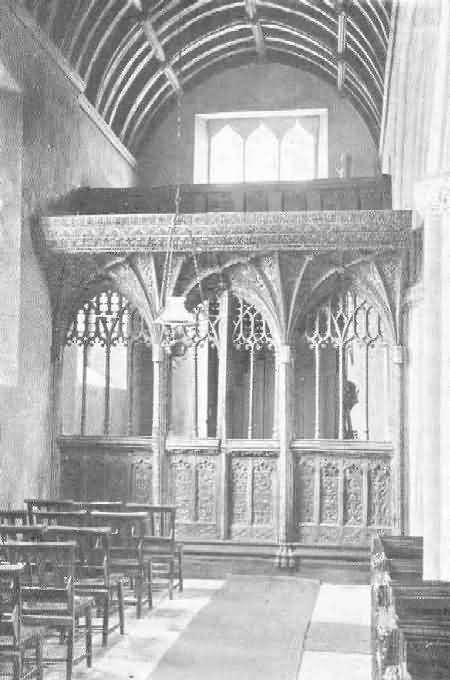
Marwood: North Aisle Screen
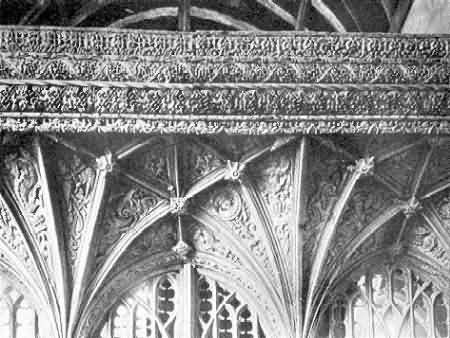
Marwood: Detail of Carving of Groining
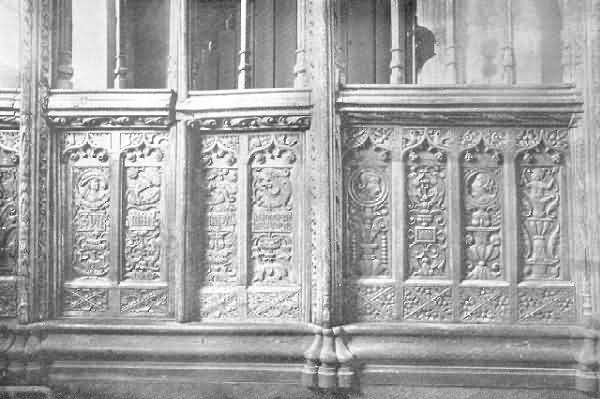
Marwood: Carving on Panels of Screen
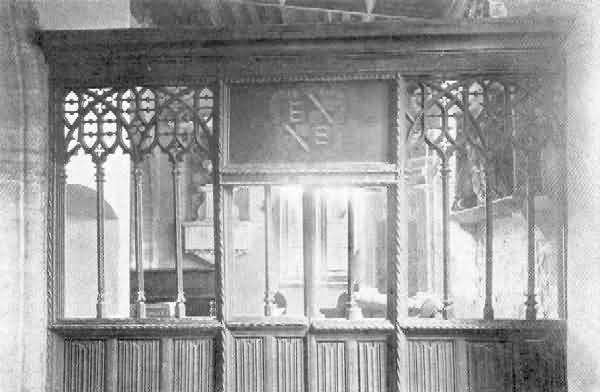
Membury: South Aisle Screen
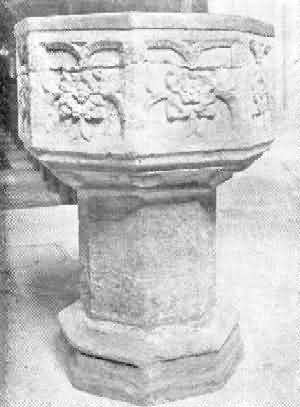
Membury: Font
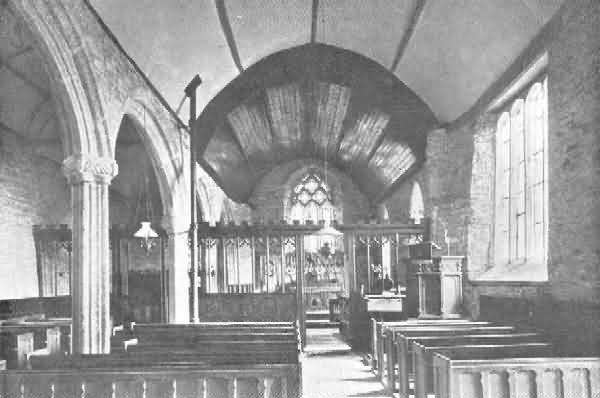
Milton Damerel: Interior
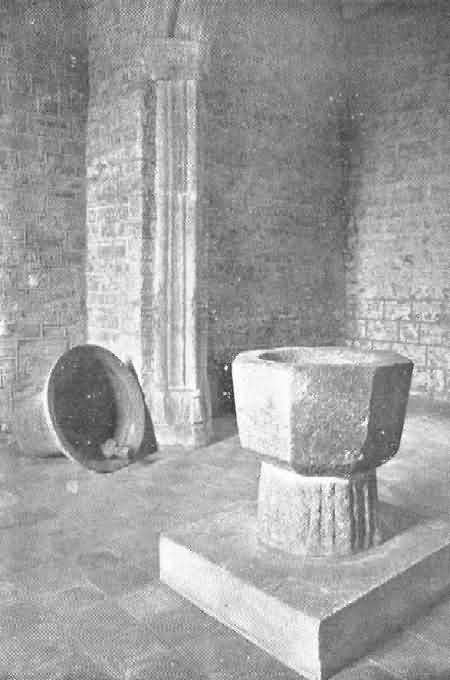
Milton Damerel: Font
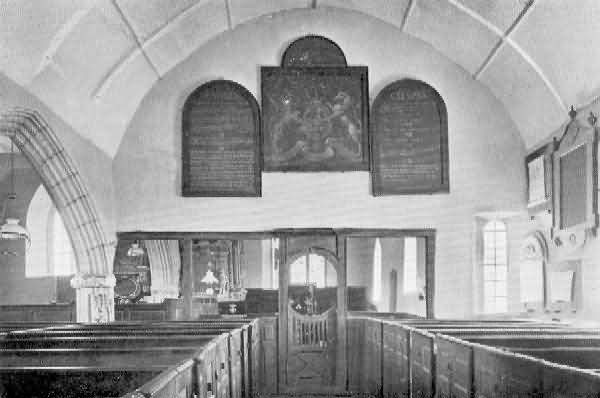
Molland: Interior
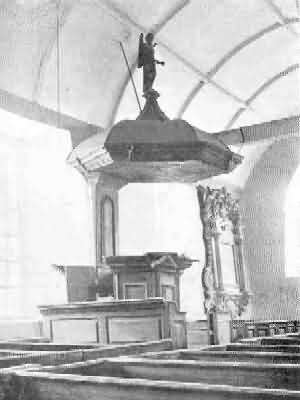
Molland: Old Pulpit
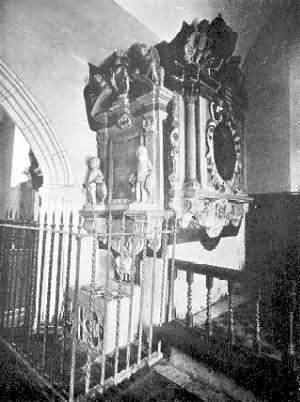
Molland: Courtenay Heart Stone
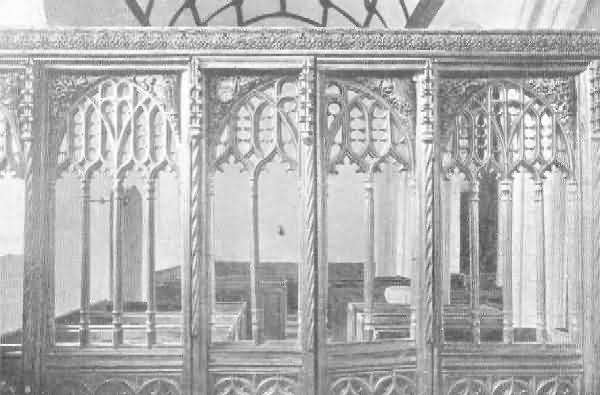
Monkleigh: Screen In Annery Chancel
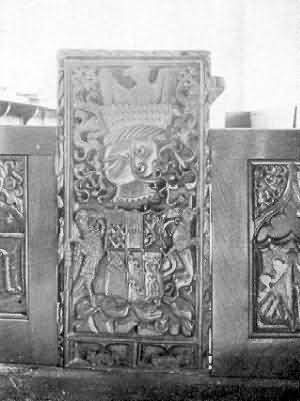
Monkleigh: Bench-End
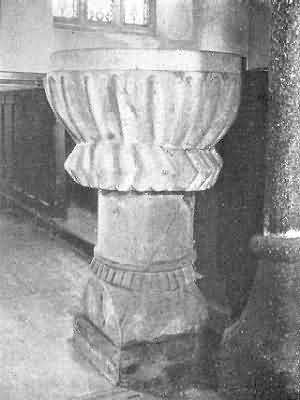
Monkleigh: Font
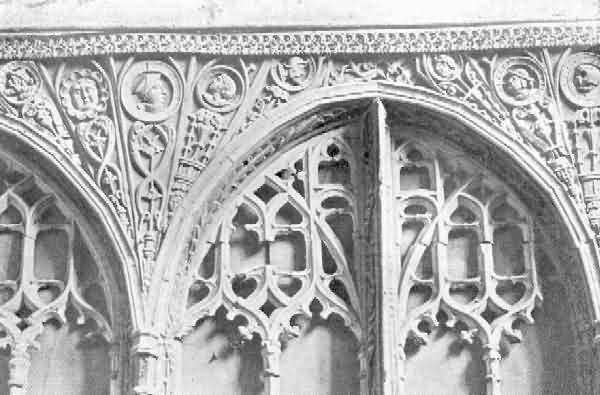
Morchard Bishop: Remains of Screen
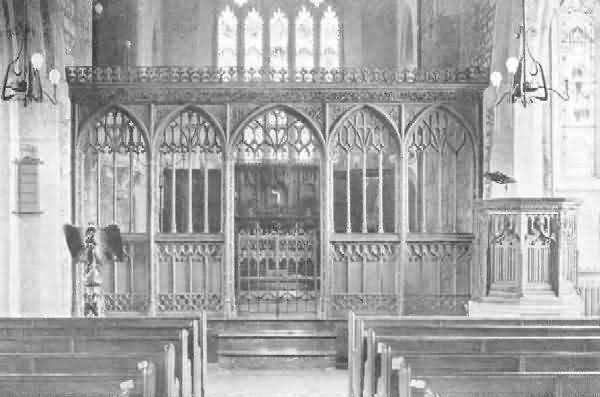
Moretonhampstead: Rood Screen
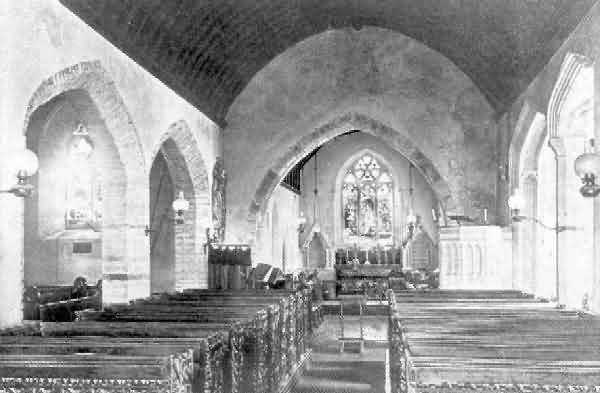
Mortehoe: Interior
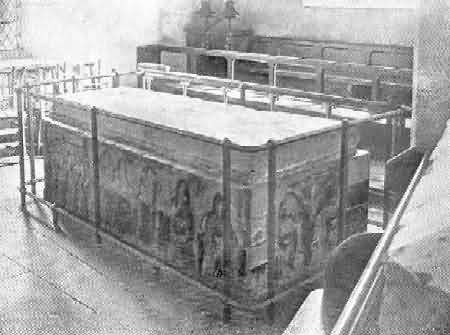
Mortehoe: Tracey Tomb
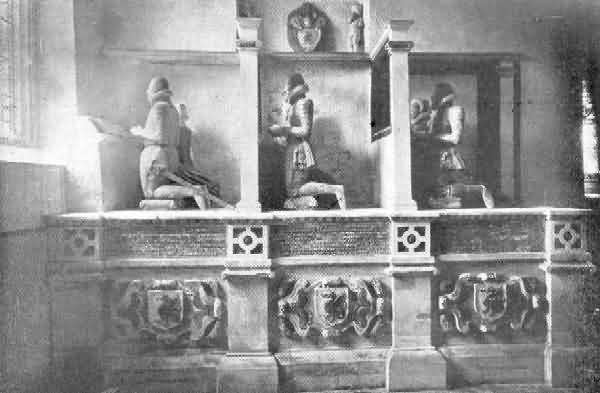
Musbury: Drake Monument
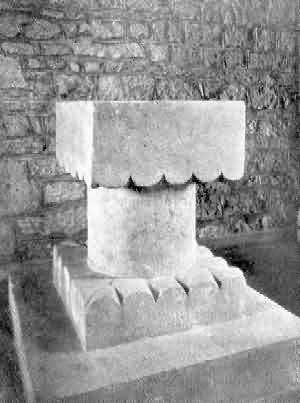
Netherexe: Font
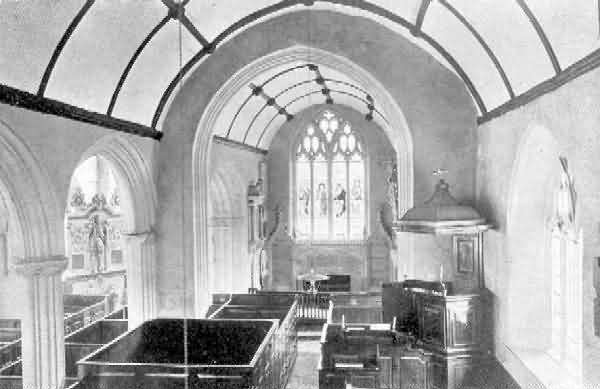
Newton St. Cyres: Interior
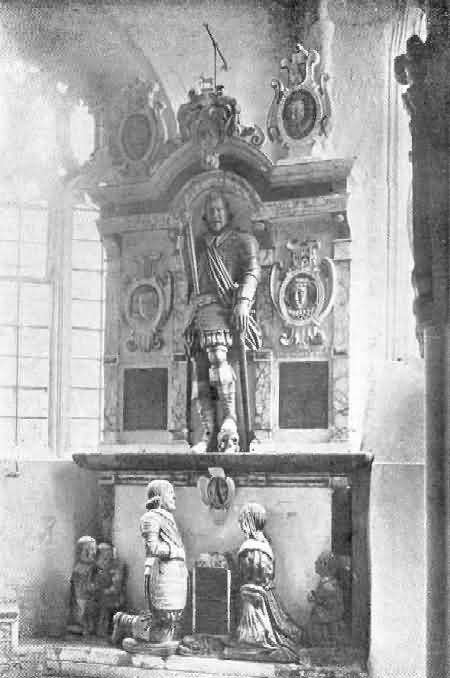
Newton St. Cyres: Northcote Monument
«Some Old Devon Churches»:
Index; 169-180
[Dr. R. Peters: rpeters@wissensdrang.com]